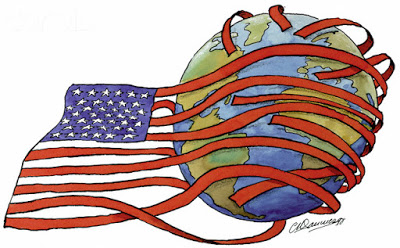Summary:
High-wage economies of Canada, EU, Japan and Australia account for nearly half of US corporate employment abroad.
And even in low-wage regions, the high-wage parts tend to draw more US employment.
The new US administration may have second thoughts about pivot to Asia, but US companies may not.
The US economy created roughly nine million net new jobs since the start of 2009. Through organic growth and acquisition, majority-owned affiliates of US multinational companies have also expanded their employment outside the US.
It is interesting to see where US companies hire foreign workers.The Bureau of Labor Statistics tracks this, but the most recent data is only through 2014.
Of the nine million net new jobs in created in the US since 2009, a little more than half (4.82 mln) were created between 2009 and the end of 2014. During this period, the majority owned affiliates of US companies increased their payrolls by roughly three million to 13.8 mln.
The situation is considerably more complicated that simply pursuing lower wages, which seems to be the conventional understanding on both the political right and left. High wage economies in the EU, Canada, Japan and Australia, account for almost half of the overseas employment (6.4 mln). US affiliates are employed about 2.5 mln people in the UK, Germany, and France, alone, and nearly 1.2 mln in Canada.
Moreover, in regions that ostensibly have lower labor costs, like Central America, US companies concentrate in the relatively higher wage areas. For example, of the approximately, 1.5 million employees of US affiliates in Central America, Mexico accounts for almost 1.3 mln, leaving the lower wage Guatemala, Honduras, Nicaragua, Costa Rica and Panama, to divide up the remaining 200k jobs.
The same is true of Africa, where US affiliates hired less than 250k employees, with more than 40% accounted for by South Africa. US companies employed 31.2k in Egypt and 10.5k in Nigeria. That means that in rest of the continent, another 100k people work for majority-owned affiliates of US companies. Of the 136k employees of US companies in the Middle East, the relatively high wage Israel accounts for over half.
In 2014, US majority-owned affiliates employed 1.67 mln people in China and 1.12 mln in India.There may be a wage inducement in these countries, though, by most measures, India has lower wages than China. However, India may also be less engaged in low-wage manufacturing and more involved in business services, like accounting, research, phone centers, and customer support activities.
US companies want to be close to their customers. Big economies have an advantage. China is the world’s second-largest economy, though according to some purchasing power parity measures, it is larger than the US. Similarly, India, which is the seventh largest economy in nominal terms may be the third largest using some PPP measures.
While these are the “stock” of foreign employees at majority owned affiliates, we are also interested in the “flow” or the change over the 2009 to 2014 period. Modest changes were seen in Canada, Japan, and Europe. US affiliates hired 104k more Canadians (9.6%), 28.6k Japanese (9.2%) and 410k European (9.9%). Of these new jobs in Europe, the UK accounted for 146k, which is a 35% increase in British employment at US companies over this period. Note that US affiliates hired fewer people in 2014 in Belgium, Finland, France and Spain, than in 2009.
Brazilians working for US affiliates increased by 177k, which is a 34% increase. An additional 322k Mexicans are employed as US majority-owned affiliates, which is about a 32% increase. African employment by US companies increases by 46.4% or 75.6k people. South Africa accounted fro the majority (48.5k) which is nearly an 84% increase.
Employment at majority-owned US affiliates in the Asia-Pacific region rose by almost 1.8 mln people in the 2009-2014 period. This represents a 56% increase. Almost three-quarters of this increase are accounted for by China and India. US employment in China increases by 730k people or 77.6%. US employment in India increases by almost 600k people or 115%.
We will address in future notes why the US has pursued a direct investment strategy rather than the traditional export approach. Suffice it is here to simply note that the employment by the majority-owned affiliates of US companies abroad cannot be simply explained by the pursuit of low wages.
Full story here Are you the author? Previous post See more for Next post
Tags: jobs,newslettersent,US











































